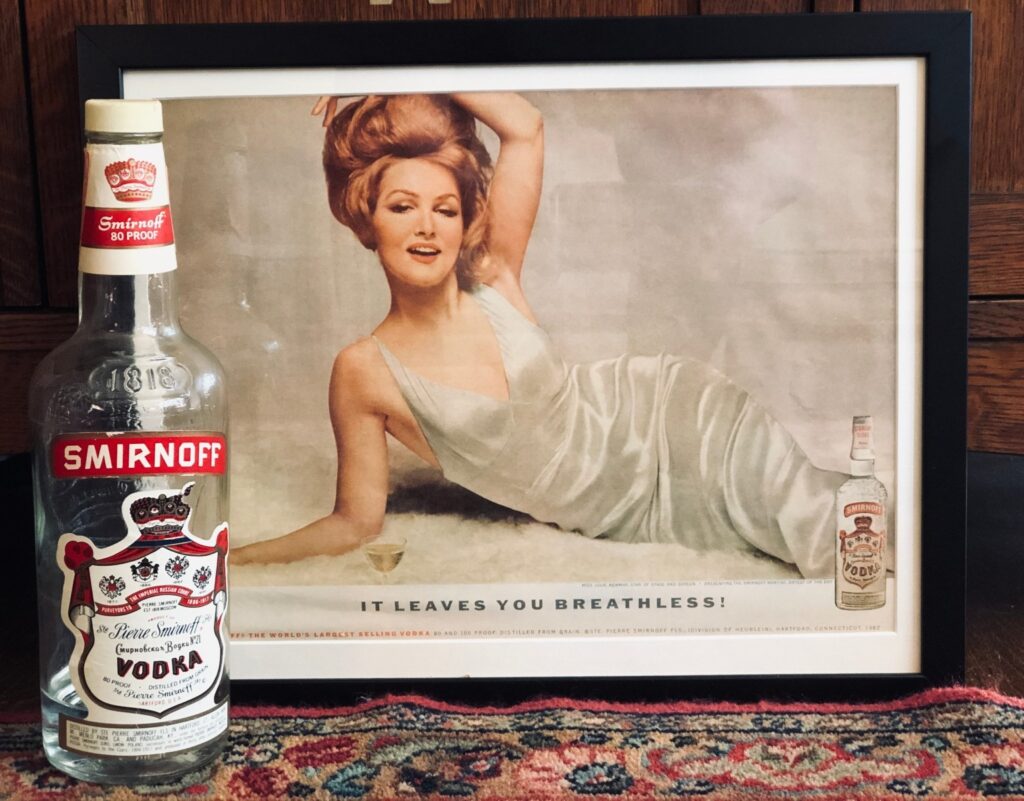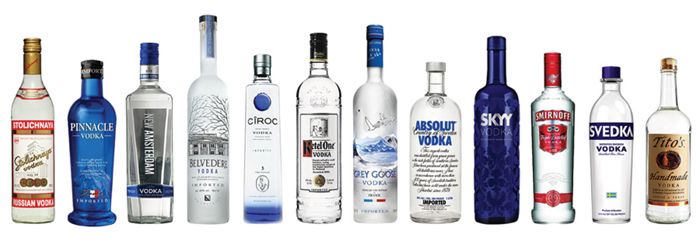- Vodka isn’t Russian
Vodka was first created in the Middle Ages in what is now Poland, and the first written mention of it is from 1405. It didn’t enter modern day Russia for almost a century, and like all alcohol of the day was used primarily as medicine. Polish physician Stefan Falimierz wrote in his 1534 book on herbs that vodka should be “used to increase fertility and awaken lust”. By 1860, with control of all distilling by the Czar, and a government policy promoting state-manufactured vodka, it became the drink of choice for Russians. By 1911 vodka comprised 89% of all alcohol consumed in Russia – and they drank a lot of it. But Americans were not interested. They liked their liquor brown, or in the case of gin, flavorful.

- Vodka doesn’t come from potatoes. Necessarily.
Well, sometimes it does. But the vodka you are likely drinking comes from grain – with rye being the most common. Unlike bourbon which must be made from 51% corn, as a neutral spirit with no taste or smell vodka can be made from barley, wheat, rye, corn or – potatoes. Some European vodkas are even made from grasses. All the big names in vodka; Grey Goose, Smirnoff, Stolichnaya, and Ketel One, are made from grain. The grains result in less flavor, while potatoes end up giving the spirit a slight, but distinctive taste. Most people associate potato vodka with Russia, but there are virtually no vodkas made in Russia from potatoes. Rule of thumb – you want a grain vodka for mixing cocktails. If you are looking to sip, you might search out a niche craft distillery making potato vodka. Or one that makes it from salmon or old newspapers. Yes, that’s a thing too.
- By law, vodka must have no smell or taste
Vodka is required to be flavorless and odorless – other than flavored vodkas. It is basically ethyl alcohol with enough water to bring it to an acceptable alcohol content. Experts and distillers claim they can sense ‘taste overtones’ of the base grains or potatoes – but for the average drinker all vodka is the same. And when you dump a bunch or orange juice in with it – the differences between all the major players in the vodka world goes away. There is one major difference however – marketing. Some big companies are very good at convincing you that their vodka is better than the competition.
- Vodka didn’t come to America until after prohibition.
Russians who immigrated to the United States in the 1800s brought vodka – but it remained such a niche product it was hardly noticeable. The Soviet Revolution began in 1917 during World War I and lasted until 1923 when the Soviet Union was established. White émigrés, or first wave émigrés, began leaving in 1917 as the uprising began, and between 1917 and 1920 it is estimated that as many as 2 million military officers, Cossacks, intellectuals, businessmen, and landowners fled Russia, and they brought vodka with them. They first arrived in Turkey, then spread to Eastern Europe, and finally large populations ended up in Western Europe, especially large cities like Paris. But with Prohibition still in full swing, it would take another decade for vodka to reach America, and another two after to be accepted.

- The Bloody Mary was created to find a drink that worked with the new spirit.
Once Prohibition hit, the center of the cocktail world shifted from New York City to London and Paris. As the Russian émigrés settled in the large cities in western Europe, vodka was added to the back bar. But no one knew what to do with it other than drink it straight. The only drink of that era with legs to become a classic is the Bloody Mary, invented by bartender Ferdinand ‘Pete’ Petiot, at Harry’s New York Bar in Paris in 1934.
- The Moscow Mule started America’s love affair with vodka.
In 1941, Jack Morgan, owner of the Cock’ n Bull bar in Los Angeles was meeting with John Martin, an executive of the Heublein drinks company, the distributor of Smirnoff vodka. Morgan was complaining about excess inventory of a house-made ginger beer in the basement of the bar, and Martin was complaining about the lackluster sales of their vodka. At the same time (so the legend goes) Russian immigrant Sophie Berezinski walked in, looking to sell 2,000 custom copper mugs made by her father’s copper company. Probably a tall tale (Cock ’n’ Bull bartender Wes Price also claims to have created the drink), but the Moscow Mule was born that day. They hatched a plan to serve the drinks in the iconic copper mug, and it took off. Sales of the Moscow Mule – and vodka – soared.

- The Moscow Mule was once branded as anti-American
In the early 1950s at the peak of McCarthyism, there was a huge backlash of all things Russian. Spurred on by the relentless anti-Communist speeches by Sen. Joseph McCarthy, bartenders in New York and Los Angeles tried to create a nationwide boycott of the Moscow Mule – and vodka. The negative press hurt both, but Morgan was able to tamp down the fears when he fought back, reminding everyone that Smirnoff was made in Connecticut, not the Soviet Union.
- Smirnoff vodka is an American product, while Stolichnaya is Russian.
Smirnoff vodka is the world’s bestselling vodka. P.A. Smirnov began distilling vodka in Moscow in 1866, and it quickly became the official vodka of the Czar. During the Revolution, the royal family and all those who catered to them were either captured or fled. In 1919 Vladimir Smirnov, his company and distillery taken by the revolutionaries, fled Russia and in 1933 he signed a deal with Rudolph Kunett, a Russian émigré in New York, to begin distilling and selling vodka produced in the United States. He changed the name to Smirnoff and aggressively began marketing. Stolichnaya began in the Moscow State Wine Warehouse No. 1 in 1901, and while it’s exact date of birth is unknown, the Soviet brand is assumed to have been created by V. G. Svirida around 1944. It remained the State-owned vodka until the dissolution of the Soviet Union in the early 1990s. Fun Fact #1 – I drank shots of Stoli back in 1985 with a group of Soviet students in Moscow during a semester abroad. It was the first time they had ever tasted it. Stolichnaya was reserved for tourists and export only, leaving the rot-gut vodka for the citizens. Soviets could not buy it (or walk into the international hotels). Fun Fact #2 – this is where I learned the hard way that it is bad form to cap a bottle of vodka while making toasts with new friends. You drink until the bottle is empty (and then usually someone buys another bottle).

- The Three Martini lunch brought vodka to work
In the 1950s, American whiskey and bourbon entered an overproduction cycle. Unlike vodka and gin that are primarily unaged, whiskeys need to sit in a barrel and production needs to anticipate future demand. The price of the brown spirits dropped due to excess production in the 1960s and most connoisseurs, sensing that quality was to blame, began shifting over to Scotch. That left an opening for vodka. The spirit became huge in Hollywood in the 1960s. There had been a number of ‘moral failings’ of Hollywood stars during the 50s, and contracts began to include clauses against drinking in an effort to purify Hollywood’s image. Smirnoff, either capitalizing on it, or falling into it, began their now famous “It takes your breath away” campaign. The ad was brilliant – telling everyone on one hand that the product was so good, it left you breathless, And on the other hand – that it couldn’t be smelled on your breath. Movie stars immediately embraced the neutral spirit – and so did corporate America. After a liquid lunch, you didn’t smell like a brewery or distillery.

- Vodka is the largest selling spirit in the US
In 1950, only 40,000 cases of vodka were sold in the Unites States, but by 1955 that number had jumped to 4 million. By 1967 it had surpassed gin, and thanks to the big fruity drinks that hid the taste of the alcohol like the Tequila Sunrise, it surpassed the all-American whiskey in 1976. While sales have slumped recently, it still reigns as king. At least for now. Whiskey sales are expected to become America’s bestselling spirit once again within the next several years.
Cheers!
Bill
AotCB-032



